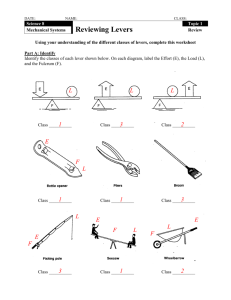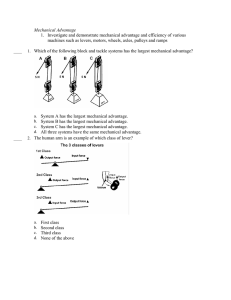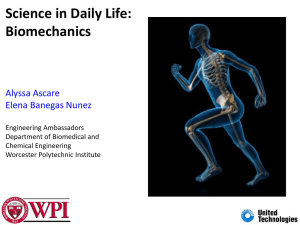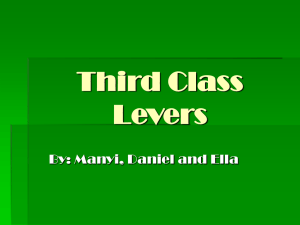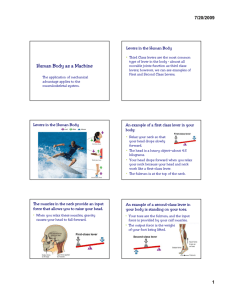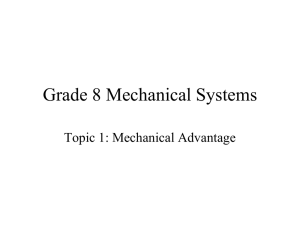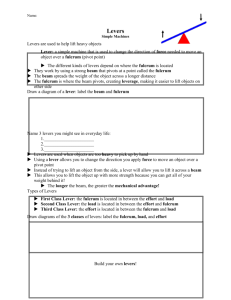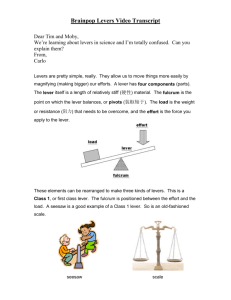Simple Machines
advertisement
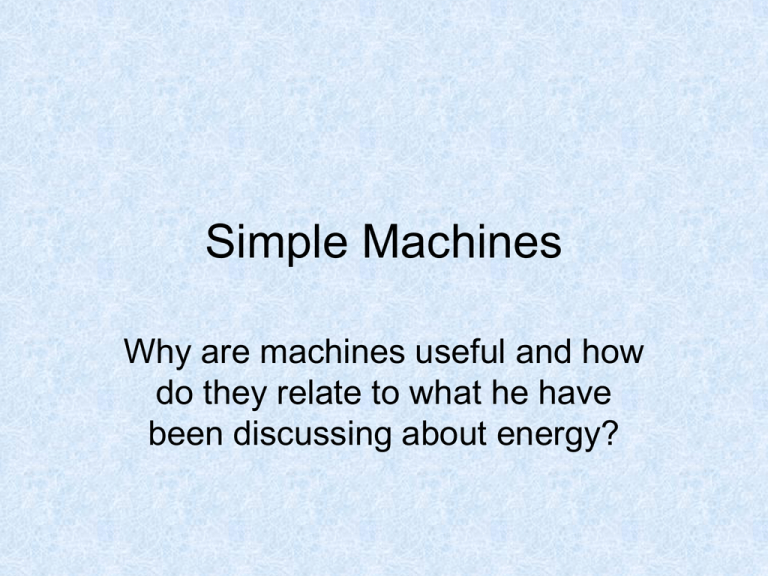
Simple Machines Why are machines useful and how do they relate to what he have been discussing about energy? Simple Machines A machine is a devise used to either change a force or redirect a force. These machines (whether you notice them or not) are involved in every activity that you participate in. The reason for this is that they range from the very complicated machines you generally think of when you think of a factory assembly line, to individual joints in the human body. Simple Machines There are a number of different types of simple machines, all of which work on the same principle: doing work Some types of simple machines: Pulleys Levers Ramps Simple Machines We know: W F d By changing your input distance you can in turn change your input force. The key to any simple machine is that regardless of how you change this input force or distance, the work you put into a task will be equal to the work you get out of it Simple Machines All of these machines can be used to change either an input or output force based on how much YOU move. In general a machine is useful because it allows you to input less force to move something that requires a greater amount of force. The trade off for this is that, in order to allow you to push softer, you must move farther. Take for example…. Levers A lever is a machine that has 3 major parts: Resistance (Resistive force) (Load) Fulcrum Input Force (Effort) You can change what effort you put into a task by changing the distance you must move during that effort. Levers The work done on one side of the fulcrum must be equal to the work done on the other side NO MATTER WHAT! 200 N 200 N Fd = Fd Levers work input = work output F d d F (force x distance)input = (force x distance)output Mechanical Advantage 80 N F 1m d d 10 N ____ m F Mechanical Advantage = (Foutput)/(Finput) = 80/10 = 8 Type 1 Lever (1st class) First-class levers have the fulcrum placed between the load and the effort, as in the seesaw, crowbar, and balance scale. Type 1 Lever (1st class) Gluteus Medius (Lifting a leg, stabilizing hips or shifting weight) Type 2 Lever (2nd class) Second-class levers have the load between the effort and the fulcrum. A wheelbarrow is a second-class lever. Type 2 Lever (2nd class) Type 3 Lever (3rd class) Third-class levers have the effort placed between the load and the fulcrum. The effort always travels a shorter distance and must be greater than the load. Type 3 Lever (3rd class) This is the most common type of lever utilized by the human body. Levers Question What is the mechanical advantage of a 1st class lever whose fulcrum is closer to the load? The load has a weight of 400 N and moves a distance of 0.2m. You move your end of the lever 1 meter. Pulleys A system of pulleys can be used to either change the direction of a force or change the input force to move a load. *MA = Mechanical Advantage Pulleys You can change the mechanical advantage of a pulley system by changing the complexity of the pulley system MA = 1 MA = 2 For the second situation, you must pull a length of rope twice the magnitude that the load gets lifted. (Because work is equal on both ends) Ramps (Inclined Planes) By increasing the distance that you move a load, you can decrease the force you must input to lift it to a specific height. Ramps (Inclined Planes) d d Efficiency efficiency = efficiency = actual mechanical advantage theoretical mechanical advantage Output Work (Wout) Input Work (Win)

